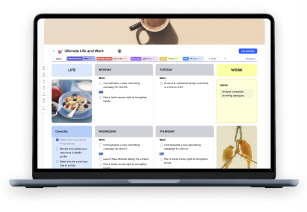A 30-60-90 day plan is an important tool to help you speed up in a new role, a roadmap for your professional development and success in the first 3 months of a new job or project. For people who have started their first job or migrated from another industry, this concept might be quite hard to comprehend, and the plan itself is too complicated to build. This also applies to managers who need to gain relevant experience but still have to assist their employees.
Whether you’re a new hire, a manager onboarding team members, or a business owner looking to optimize your onboarding process, understanding how to create and implement a 30-60-90 day plan is key to success in today’s busy corporate world.
A specifically designed template might help with comprehending the idea and building your plan. It’s also a great tool for managers who have to do it all the time, helping new hires. This guide will take you through the process of creating a 30-60-90 day plan using the xTiles 30-60-90 plan template so you can set goals, understand the company mission, and make a positive first impression.
What is a 30-60-90 day plan?
A 30-60-90 day plan is a structured onboarding and goal-setting process for a new hire, manager, or anyone starting a new position in an organization. This plan outlines specific, measurable goals and key metrics for the first 30, 60, and 90 days in a new role. It helps new team members get up to speed and align their personal goals with the company goals.
The purpose of a 30-60-90 day plan is:
- To provide a framework for the onboarding process
- To set realistic goals and expectations for the first 3 months
- To show initiative and commitment to the new role, project, and company overall
- To speed up the learning phase and integration into the company culture
- To understand the job description and responsibilities
- To build relationships with key stakeholders and other team members
- To lay the foundation for long-term success, cooperation, and career development
By breaking the first 3 months into 30-day chunks, new employees can focus on specific objectives and priorities and gradually take on more responsibility. This structured approach reduces overwhelm and means new hires can contribute to the team and company’s mission from day one.
Advantages of a 30-60-90 Day Plan
A 30-60-90 day plan is good for both sides – new employees and the company- who decide to use them. Among all the benefits iе can bring, here are the most significant ones:
- The structure helps newbies learn about their role and the company much quicker than if they would figure it out independently.
- Having a plan reduces the anxiety a new hire might experience. It gives a new team member confidence in themselves to succeed. Even though the future might be vague, at least the next 3 months are clear.
- The plan helps newcomers prioritize and manage their time better during the critical first few weeks.
- By having concrete goals and measurable objectives, people can contribute to team goals sooner.
- The plan encourages engagement with the company’s mission and values from day one.
If you’re a new employee, presenting a 30-60-90 day plan shows you are proactive and committed to the new role. If you’re a manager, presenting a 30-60-90 plan shows that the company supports its new hires. It’s a win-win situation for both parties.
Structure of a 30-60-90-Day Plan
A 30-60-90 day plan is divided into 3 phases, each with its objectives and priorities. This allows new employees to get used to the new environment, take on more responsibility gradually, and make a big impact in their new role.
First 30 days: Acclimation and learning
The first 30 days are critical to setting you up for success in your new role. In this phase, a newcomer needs to:
- Get to know the company’s values, goals, and pain points so you can align your efforts to the big picture.
- Connect with their direct reports, other team members, and key stakeholders to build a network within the company.
- Get familiar with the company’s systems, processes, and resources. Attend training sessions and take online courses if available.
- Work with the hiring manager to set specific, measurable, achievable, relevant, and time-bound goals (SMART goals) for your role.
- Watch and ask. Take note of the company’s operations, challenges, and opportunities. Don’t be afraid to ask questions about your role.
The first month is crucial for your adaptation and learning the process within your new company, getting to know your new team members and how they work, the work environment you’re becoming a part of, etc. Also, since it’s a 30-60-90 plan, try to accomplish only some things during these first weeks. Give yourself time to fit into your new role seamlessly.
Next 30 days (60-day mark): Taking initiative
Now that you’re into the second month, it’s time to move from learning to doing. This phase is about:
- Applying what you’ve learned. Contribute to projects and team goals.
- Suggest new ideas or ways to improve existing processes based on what you’ve seen.
- Take on more tasks and show you can handle more complex work.
- Get involved in cross-functional projects to get a broader view of the company.
- Schedule a review with your manager to check your progress and adjust as needed.
After the first month, you already know a lot about the company, its mission, your part in it, etc. So, the next month will be a bit easier, but with new challenges and goals. If they are planned and set properly, you will know your priorities for this time and how to measure success.
Final 30 days (90-day mark): Making an impact
Now’s the time to cement your position and make a big impact during your third month.
- Show tangible outcomes, e.g., successful sales calls or completed projects.
- Start new projects or take ownership of key responsibilities within your team.
- Share your thoughts and contribute to strategic discussions about the company’s future.
- Based on what you’ve learned, set new goals for your growth and contribution to the company.
- Review your progress: Reflect on your journey so far, what you’ve done well, and what you can improve.
The 30-60-90 day plan is your guide to getting from learning to contributing to being a valuable part of the company.
Types of 30-60-90-Day Plans
While the structure of a 30-60-90 day plan remains the same, the content and focus will vary depending on the situation. Let’s look at three types of 30-60-90 day plans:
For managers
Managers in new roles have it tough; they need to quickly get to know their team and align their efforts with those of the broader organization. A manager’s 30-60-90 day plan should focus on:
First 30 days:
- Meet with direct reports and key stakeholders to understand what’s going on and what’s broken.
- Review team metrics and identify areas to improve.
- Get to know team members’ strengths and weaknesses.
60 days:
- Implement fixes to the problems identified.
- Set clear expectations for the team.
- Start to optimize team productivity.
90 days:
- Lead the team to set and achieve measurable goals.
- Do performance reviews and give feedback.
- Present a long-term plan for the team to upper management.
Starting a new position as a project manager is challenging. You need to become a part of the team and build relationships with the executives and stakeholders. Doing so without a plan and relevant resources might be a mission impossible.
For job interviews
Using a 30-60-90 day plan during the interview process will set you apart from other candidates and show you’re proactive. This type of plan should:
First 30 days:
- Show you’re committed to learning about the company’s mission and culture.
- Outline how you’ll build relationships with new colleagues and team members.
- Demonstrate you understand the job description and initial responsibilities.
- Discuss your performance goals for the first three months.
60 days:
- Propose how you can contribute to team goals and ongoing projects.
- Show you understand industry trends and how they relate to the role.
- Outline how you’ll take on more responsibilities.
90 days:
- Present concrete goals to make a big impact in the role.
- Show how you’ll align your efforts with the company’s big picture.
- Show you’re committed to ongoing learning and development.
Since this is only an interview and you don’t have access to the company information yet, the plan can’t be detailed, but if you’re hired, it will become an outline for the actual plan. If you’re applying to multiple companies, preparing numerous 30-60-90 plans will be time-consuming. That’s why you may use the xTiles 30-60-90 plan template to save time.
For a new team member
Newbies can use a 30-60-90 day plan to navigate the onboarding process and hit the ground running:
First 30 days:
- Follow the onboarding plan provided by the company.
- Attend training sessions and complete any online courses.
- Start building relationships with team members and key stakeholders.
60 days:
- Take on small projects or tasks.
- Find ways to contribute to team goals.
- Ask the hiring manager for feedback on performance so far.
90 days:
- Own specific projects or responsibilities.
- Show measurable contributions to team objectives.
- Set new goals for growth and impact in the company.
Whatever the plan, make sure to set achievable goals that align with the company’s mission and your own career goals. Remember to be flexible – you’ll need to adjust as you get to know the role and the company.
How to Create an Effective 30-60-90 Day Plan
Creating an effective 30-60-90 day plan requires careful consideration and strategic thinking. Normally, it also requires some basic skills to create a responsive and visually appealing document, but if you decide to use the xTiles 30-60-90 plan template, this part is already done.
Let’s imagine you’re a new employee and create this plan step-by-step. Here’s a guide to help you develop a plan that boosts success and progress:
Setting concrete and measurable goals
You might feel very ambitious starting a new role in a new company but still try to keep the goals achievable. Also, if you want to outwit your company by setting goals that are too easy, you might show that you don’t want to develop professionally. So, there’s a thin line between a plan that works for you and a plan that can bring you down. If you’re not sure how to set goals that will contribute to your success, you may try the SMART goals methodology.
Start by reviewing your job description and the company’s mission. You need to ensure your goals mirror these aspects. Also, that’s the best starting point if you have only a general understanding of what you will need to do in your new role.
When you have a list of tasks, break down larger objectives into smaller, manageable tasks when possible. This way, you will show that you can analyze and detail the working process, understand what hides beneath bigger goals, and know how to estimate your goals realistically.
When setting your goals, be realistic about what you can achieve in each 30 days. Some companies might understand that a plan isn’t manageable for three months. However, some might still expect you to do it and will be disappointed when you fail.
Then, align your personal goals with the company’s goals. Review your job description and company’s mission one more time to ensure everything is covered in your plan. Even though the plan is about you and your development, it’s important that it evolves around the company. This way, you will show that you want to grow together and you’re actually a great match for the company.
Understanding team goals
Your 30-60-90 plan is about how you fit into the bigger picture. Understanding your team’s goals is key to aligning your efforts and making a difference. There are many things you can do, but we have only collected proven ones.
You can book a meeting with your manager to discuss team objectives. It is important to understand the direction of the team and how you fit into it. Don’t be afraid to ask questions. Your interest will prove that you want to make a difference.
Next, review any existing team or departmental strategic plans. You also may review the old plans that are already finished to see the gradation and growth and better understand what they are waiting for from you. These will give you long-term goals and ongoing initiatives.
As you learn about the team’s objectives, think about how your role fits into these bigger goals. This will help you prioritize your tasks and focus your efforts where they’ll have the most impact.
It’s also important to understand the pain points and challenges the team is facing. These are often opportunities to add value quickly. Listen in team meetings and one-on-one conversations to find these areas.
And finally, learn about existing projects and initiatives. Knowing what’s already in motion will help you not duplicate work and find ways to add value from day one.
Remember, your goal isn’t just to understand the team’s objectives but to show how you can help achieve them. By showing this in your 30-60-90 day plan, you’ll demonstrate your commitment to the team and your ability to think beyond yourself.
Identifying top priorities
To be effective in the new position, you need to identify what is most important since you are likely to achieve only a few things in the first three months. This process needs to be done systematically, and the planner must have a clear vision of the short-term requirements and the end vision.
The first step is to assess each possible task or project by its potential for creating value. Some of these include the extent to which the project is visible to other stakeholders, how it impacts key business indicators, and whether it supports organizational objectives.
Challenging assignments usually mean finding solutions for important issues, enhancing critical activities, and generating revenues. Talk to your manager and other senior employees and find out which processes are really critical for the success of the mission.
However, getting the long-term goals is crucial, though finding and getting the “low-hanging fruits” can help build the confidence and worth of the team. Seek out those chances where you can make changes that will be felt right away and are visible. These may be as basic as a process improvement, fixing a long-standing petty problem, or finishing a small but significant task. Getting quick wins is not only good for morale but also for showing that you can get things done quickly.
Check your company’s mission statement and any available strategic planning documents. Define what matters most for your business and make sure that all your priorities correspond with these interests. This alignment proves that you have your eyes on the ball and that you know what is important for the organization. It also helps to ensure that your efforts are recognized and appreciated by the upper management of your organization.
Strike a balance between addressing immediate needs and contributing to long-term objectives. While it’s important to tackle urgent tasks, don’t lose sight of activities that contribute to the company’s future success. This might involve allocating time for learning new skills, building relationships, or contributing to strategic planning. A well-rounded approach demonstrates your ability to manage both tactical and strategic priorities.
Flexibility is key when setting priorities in a new role. As you gain a deeper understanding of your position, the team dynamics, and the company’s needs, be prepared to reassess and adjust your priorities. Regular check-ins with your manager can help ensure your priorities remain aligned with evolving business needs. This adaptability showcases your agility and responsiveness to the organization’s changing requirements.
Remember, effective prioritization is an ongoing process. Regularly review and refine your priorities to ensure you’re focusing on the most impactful activities. By mastering this skill, you’ll not only make a strong impression in your new role but also set yourself up for long-term success and career growth within the organization.
Defining progress measurements
For your 30-60-90 day plan to work, it is necessary that you set measurable goals to plan and track your progress. Not only does this keep you on task, but it also gives you documentation of what you have accomplished.
To each of the goals listed in the plan, attach objective milestones that will point to the achievement of the goal. These could be measurable (such as sales targets – for example, achieving 10% sales revenue growth) or non-measurable (for example, getting good feedback from one’s team). Make sure that these metrics are applicable to your position and to your team’s goals.
Divide your large goals into smaller goals that can be achieved for each 30 days of the program. This lays down a plan for your advancement and makes it possible for you to appreciate achievements in between the journey. For instance, by day 30, you may want to finish all onboarding training; by day 60, bring a new process; and by day 90, be in charge of a team project.
Describe how each goal can be reached and what it would mean in practice. This may be when the individual has achieved a particular performance standard, has finished a task, or has been praised by peers or supervisors. The idea of having a goal in mind is very important because it helps you remain motivated.
It is recommended that you regularly check your progress with your manager and have regular meetings. These check-ins allow for feedback, the potential for modification of the plan, and the guarantee that your actions are in accordance with the team’s goals. It is recommended to have at least one formal review every thirty days.
Whenever feasible, use numerical metrics to track your progress. Examples include the number of sales calls made, customer satisfaction scores, project completion percentages, or efficiency improvements. Quantifiable measures provide concrete evidence of your contributions and make demonstrating your value to the organization easier.
By incorporating these elements into your 30-60-90 day plan, you create a powerful framework for tracking and showcasing your progress. This approach not only helps you stay accountable but also provides a clear narrative of your achievements, setting the stage for future success in your role.
Building relationships
It is always important to establish close relationships in any new position for long-term results to be obtained. It is often thought that how well you can work with others, build coalitions, and manage politics often dictates your success. Here’s how to approach relationship-building in your 30-60-90 day plan:
To approach relationship-building, start with listing people who are critical to the success of the role. This involves your immediate supervisor, colleagues within your work team, other employees in other departments with whom you interact, and organizational executives. It means that knowing more about the organizational chart can help you make the right priorities when it comes to these connections.
If you’re a manager who works their way through the 30-60-90 plan, schedule one-on-one meetings with your subordinates, peers, and other important stakeholders. These sessions should be used to gain insight into their responsibilities, difficulties, and anticipations. Pay attention and try to find opportunities to meet their expectations at work.
You can even go further and schedule an all-hands meeting if you want to see what bothers the company’s employees. This way, as a new manager, you will show that you care and want to make a difference.
Participate in both official and nonofficial team activities. Whether it is the initial meeting to start a new project or just a lunch meeting with your team or even a “coffee with” online meeting, these allow you to develop a friendly relationship with them.
Determine who in your organization can be a source of information and advice. This means that you should target people who have performed well in similar positions or those with vast experience in the field. They may be very helpful to you as you start with your new job.
Remember, building a relationship is not an event that occurs in the first 90 days of your work. If you do this early on, you will establish your support structures that will help you in the long run and ensure you are happy with your job.
Conclusion
A good 30-60-90 day plan is an excellent guide to dealing with the most critical ninety days in a new position. It gives your work direction, defines what is expected, and shows how much you are willing to strive. The success of this plan depends on the definition of goals and measuring them with established objectives, the corporate mission, a clear understanding of teamwork, priority focus, and relationship management.
Whether you are a new employee or a newly promoted manager, a job seeker, or an experienced professional who wants the interviewer to notice him, an effective 30-60-90 day plan is a way for you to start on the right foot.
As you start making your plan, think of using the xTiles 30-60-90 day plan template to make the process easier. This tool unfolds an understanding to help you outline your plans, track goals, and offer a way how to manage ideas conveniently.
FAQ
What is a 30-60-90 day plan?
It’s a structured onboarding and goal-setting process for new hires, outlining specific objectives for the first 30, 60, and 90 days in a new role. It helps align personal goals with company goals and speeds up the learning phase.
Why is a 30-60-90 day plan important?
It provides structure for new employees, reduces anxiety, helps prioritize tasks, and shows proactivity. It also allows new hires to contribute to team goals sooner and engage with the company mission from day one.
How do I create an effective 30-60-90 day plan?
Set concrete, measurable goals aligned with your job description and company mission. Understand team objectives, identify top priorities, define progress measurements, and focus on building relationships with key stakeholders.
What should I focus on in each phase of the 30-60-90 day plan?
First 30 days: learning and acclimation. Next 30 days: taking initiative and applying knowledge. Final 30 days: making an impact and leading initiatives.
How can I use a 30-60-90 day plan in a job interview?
Present a plan showing your commitment to learning the company culture, building relationships, and contributing to team goals. Outline how you’ll take on responsibilities and align your efforts with the company’s big picture.








